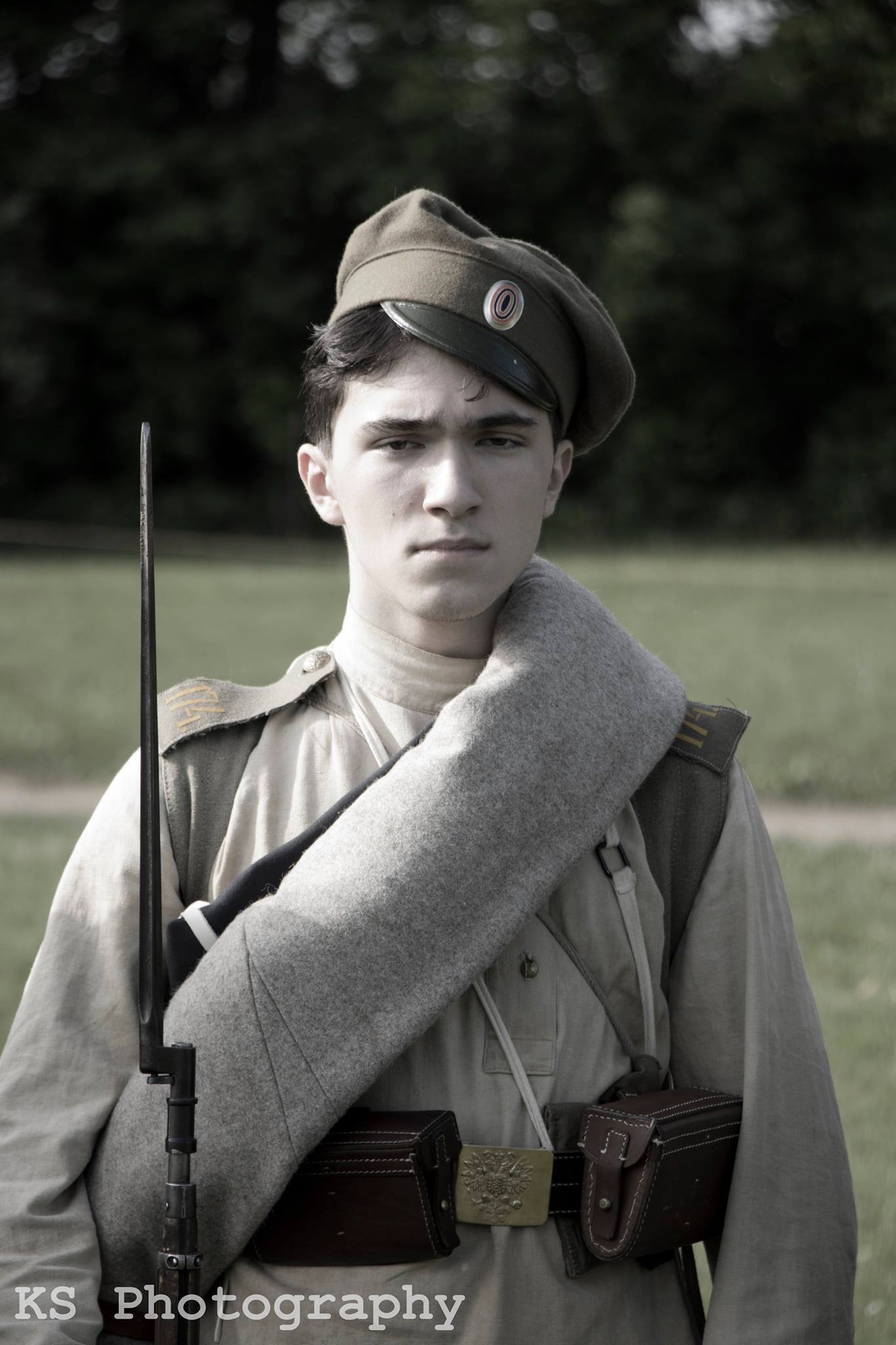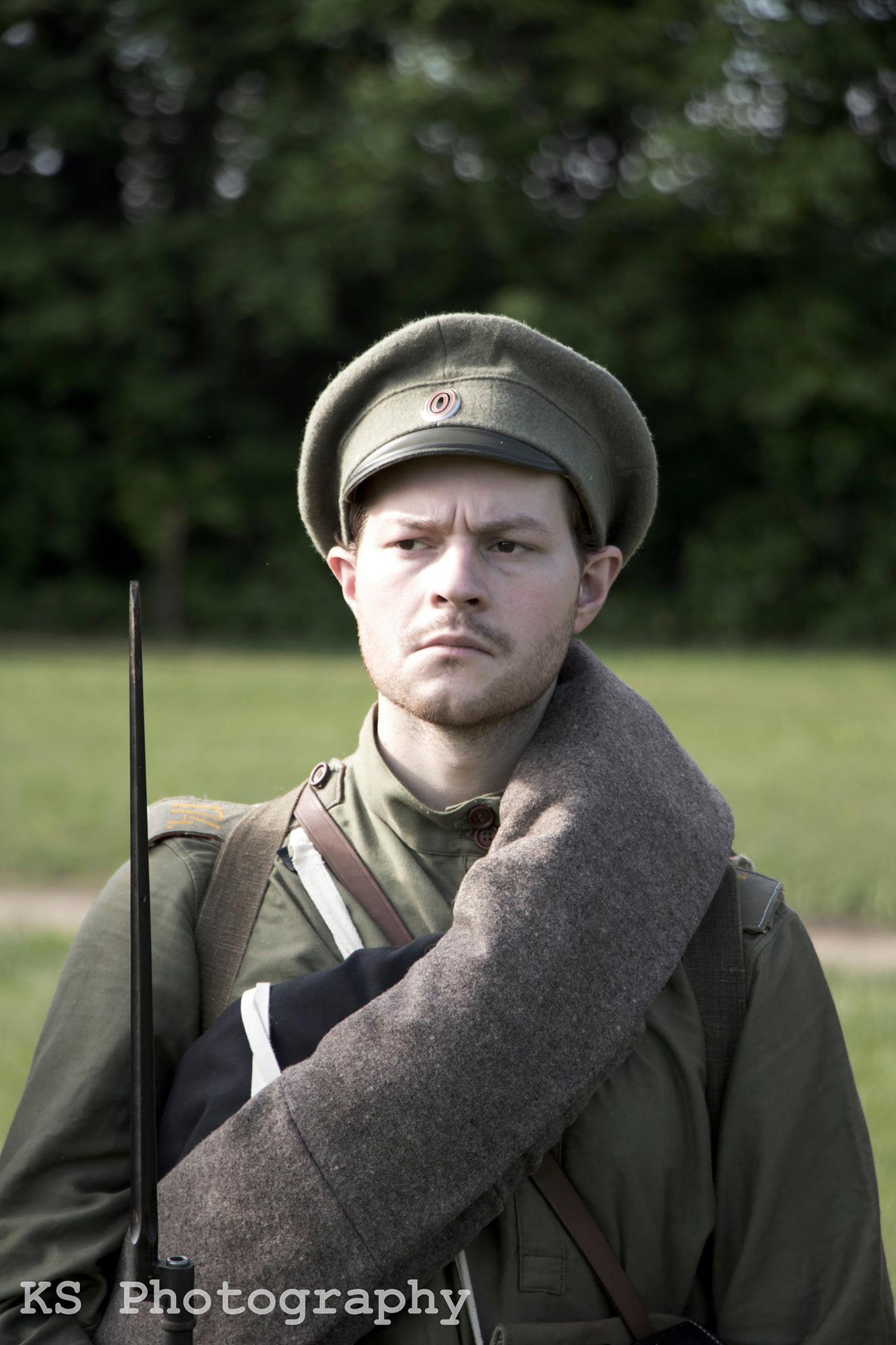Russian Imperial Army (1907-18)
By Patrick Taffe
174th Romenskiy Infantry Regiment
Historical recreation of the Imperial Russian Army of the First World War represents a unique challenge to the western, non-Russian speaking reenactor. General histories of Russia’s war focus mostly on the perils of the Romanov dynasty and the decisions of the army general staff. The smallest unit histories described in these is typically the division. Regimental histories and reports remain almost entirely still in Russian archives waiting to be translated. Similarly, a near 3/4ths illiteracy rate in Russian society at the time means that most surviving narratives of combat come mostly either from literate officers or western observers to the conflict. The version of events from the view of the average conscript remains notably missing.
Nevertheless, through diligent analysis of material culture and trawling of original photos and documents, a clearer image of the average infantryman of the Russian Imperial Army (RIA) has begun to emerge. This document is by no means perfect, as information regarding dates of issue and more precise descriptions for various pieces of gear comes filtering in more and more by the day. All this in thanks to the diligent work of other amateur historians working in the field. It is the intention of the author to add such updates to this guide as they are needed.
Prewar Army (1907-Summer 1914)
Experiences of the disastrous 1904-1905 war against Japan in Manchuria prompted limited reforms in the Imperial Russian armed forces. Uniforms were possibly the most visible aspect of this. Russian troops in bright white summer shirts and cap covers had proven far too easy a target for Japanese riflemen. As a result, towards the end of the 1905 war, frontline Russian infantry were tasked with dyeing these items in any way possible to a more subtle, field-appropriate shade. Thus making its first appearance, this would be more or less the same khaki-drab that would be worn by Russian troops once more barely a decade later at the outbreak of the First World War.
1907 presented a reform year in which a recognizably post-Manchurian war aesthetic took root in Russian regulations. The issuing of the Obr.1907 rubakha (shirt) in khaki pea green khaki signaled that “defensive” colors were here to stay. Made of plain cotton twill or rougher tent material, the 1907 tunic had two waist pockets, plain bellows-cuff sleeves, single button collar closure. Obr. 1907 tunics were topped initially with brightly-colored shoulder board insignia emblazoned with the regimental number stamped in yellow. The first and second regiments of a division, (together making up the first brigade of that division) had red shoulder boards on their tunics. Likewise, the third and fourth regiments (making up the second brigade of that division) would have blue boards. In this way, any division commander could see at a glance which regiment/brigade of his division he was addressing. Furthermore, the year 1912 saw the implementation of a reversible khaki flip side to the shoulder boards to help with concealment.

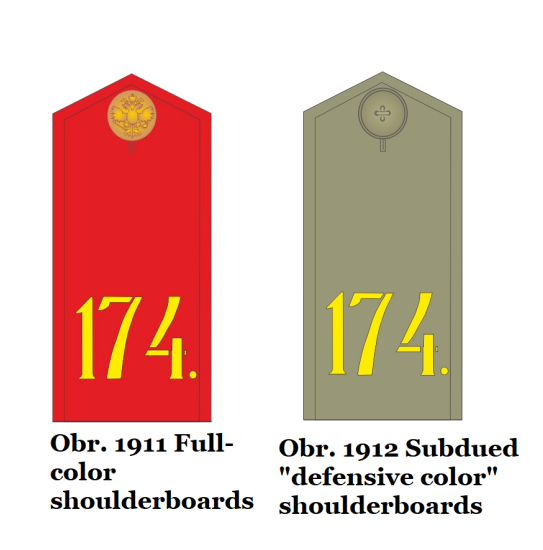
Plain black wool pants worn underneath the tunic remained constant in the prewar period and were worn for all seasons through to the outbreak of war in 1914. Pea green wool trousers would only be authorized in 1913, meaning a mix of green and black wool trousers is acceptable in the pre and early war period from 1913 to 1915. A heavy wool greatcoat (Shinyel’) in grayish-khaki color was universal year round issue for RIA infantrymen. As with the rubakha, the greatcoat would have colored, brigade specific shoulderboards sewn on, albeit of a thicker width overall and often worn without painted regimental numbers. Additionally, colored tabs on the collar of the coat specified the specific regiment of the division the coat’s wearer was from. For example: First regiment Red tabs. Second- Blue; and so on. In warmer weather, the coat would be rolled into a bedroll (skatka) and slung over the shoulder for marching and fighting.
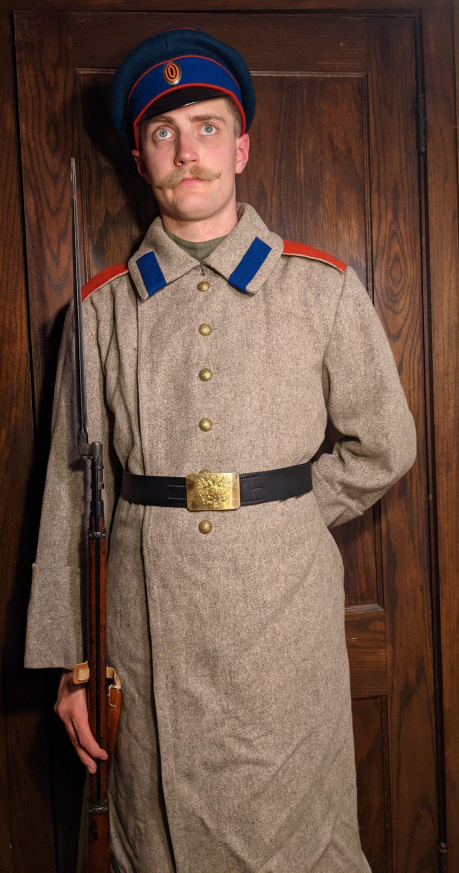
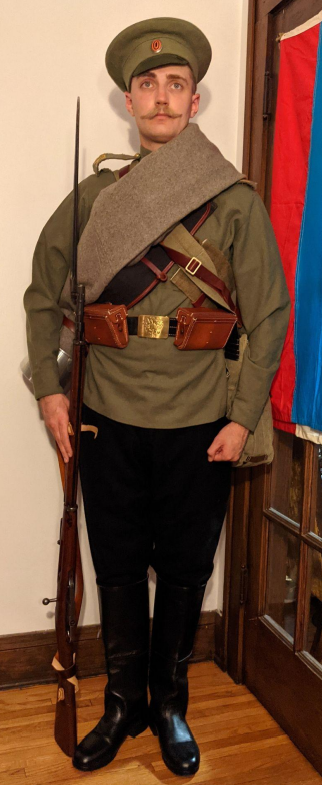
Summer 1914 - Mobilization for War
Some mixing and matching of uniform items can be seen in the first year of war. This can be explained by overlapping periods of issue for various models of tunic, trousers, and cap. For example: Obr. 1907 tunics with waist pockets are acceptable, as are Obr. 1912/1913 pocketless tunics (seen at left, distinguishable by double-button collar and cuff closures) in both wool and cotton. As the war dragged on, the 1912/13 model tunic and its wartime variations would become predominant. Regarding trousers, as mentioned previously, Obr.1907 black wool and Obr. 1913 pea green wool are interchangeable for a 1914 mobilization impression.
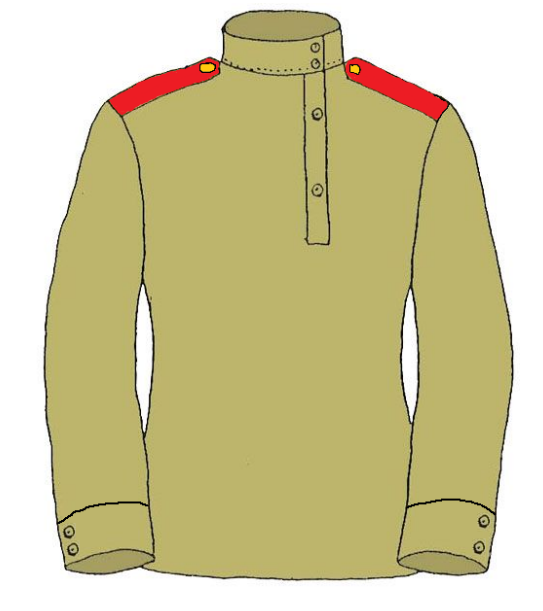
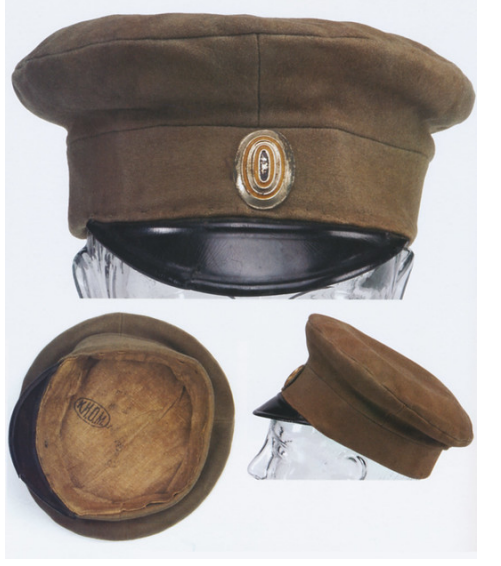
While some full-color Obr.1907 caps are acceptable in the early war period, realistically for the duration of the war the Obr.1914 furazhka (lit. “forage cap”, aka peaked cap) in pea green wool would be the most common style of cap. Model 1907 white metal cockade are required. Wire stiffener in the brim is allowed but not required. At left can be seen the first ‘layer’ of the average infantry equipment loadout in the first year of the war. Canteen in wool cover has been slung to sit on the left hip, followed by Obr. 1900 ammunition bandoleer and canvas reserve ammuntion pouch, which sits tucked behind the equipment belt and its twin Obr. 1891/1909 leather ammunition pouches.
(Take note that gear straps have been buttoned under shoulder boards.)
At right is visible the next and final layer of equipment. Large pack, or ranyets (1897 and 1909 models both acceptable) is looped through the right shoulder board to sit on the left hip with the canteen. Greatcoat roll with tent poles, mess pot, and cold weather hood are strapped to the back. Entrenching tool can be seen sitting on right hip attached to gear belt in a leather cover.
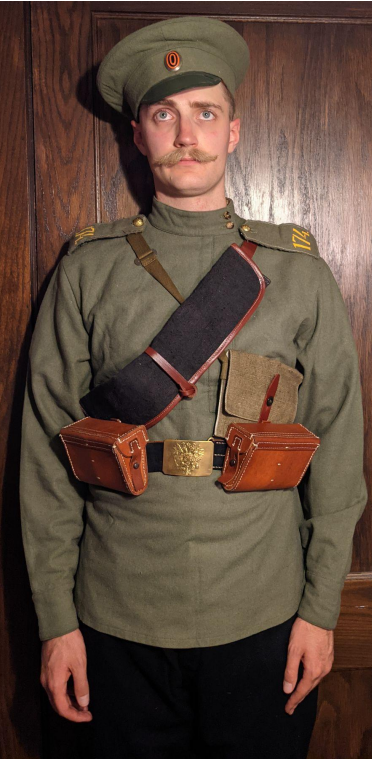

Winter of 1914-15: Battles for Galicia
1915 can be seen as a year of transition for the Imperial Russian Army, both in military situation and in overall aesthetics. Regulations ordering the subduing of shoulder boards, cockades, and greatcoat tabs had begun to be implemented, although not universally. Thus theoretically a mix of full color red and subdued green/khaki shoulder boards should be possible for this period. Likewise with prewar blue greatcoat tabs mixed with wartime subdued khaki/green tabs. Buttons on front of shinel would thus be either covered with khaki/green wool, left as is, or removed outright if applicable.
Prewar gear items were still present in large numbers, although mass shortages and Russia’s floundering war economy meant that cheaper
replacements would soon need to be found. Plain rucksacks of the “Turkestan” type, known in Russian as the vesh-meshok (literally ‘thing bag’), saw increasing use as a backpack. This model can be seen at left. Prewar model packs too, previously worn on the left hip, also begin to be worn more often backpack style by regular line infantry, (see at right) something more typically done by guards units prewar. Note that in both diagrams, the shelter half and tent poles have been strapped to the side of both the vesh-meshok and the prewar large pack.
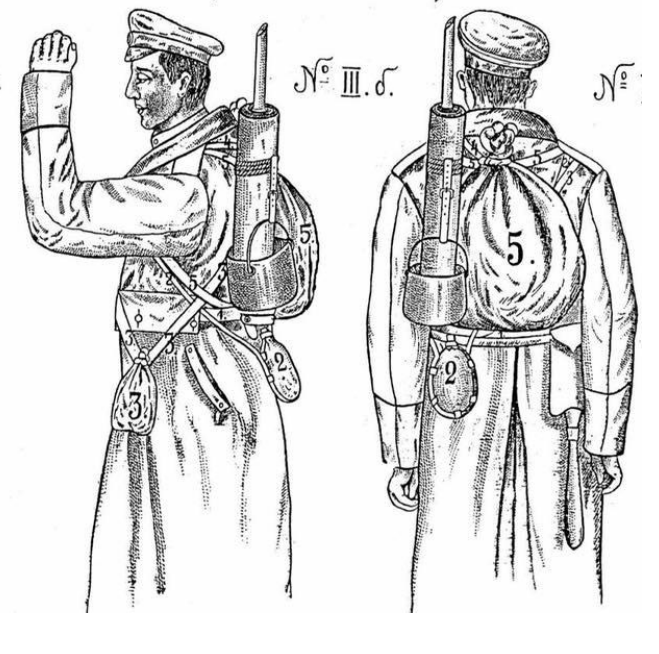
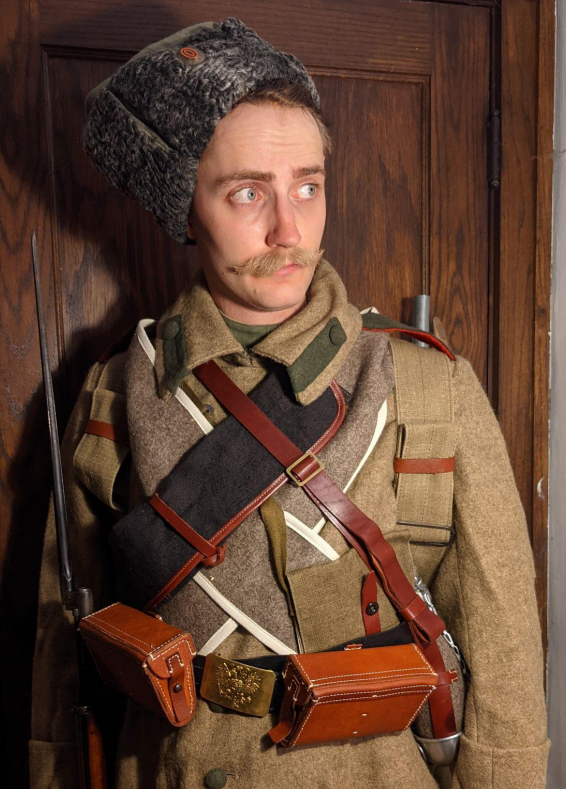
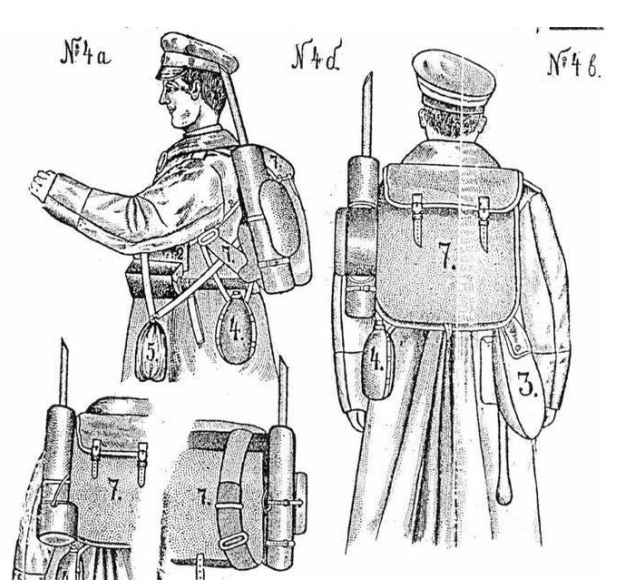
Closer view of an original pre/early war papakha fleece cap below. (Piping would be discontinued in 1914) While Obr.1910 papakhas came with the ability to be unfolded down over the ears and neck in extreme cold, this practice proves extremely rare in original photos. Reasons for this are to be debated. Whether regulations were strict in the field as to when the flaps could be let down, or the soldiers themselves kept them up as a sign of pride remains unclear.
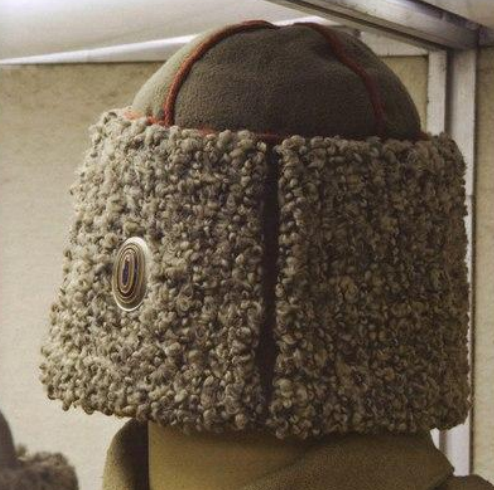
Clearer view of the prewar haversack worn as a backpack with shelter half and tent poles strapped to side below. Here the bashlik hood has been deployed over the fleece cap – a sign of truly bitter cold to be sure!

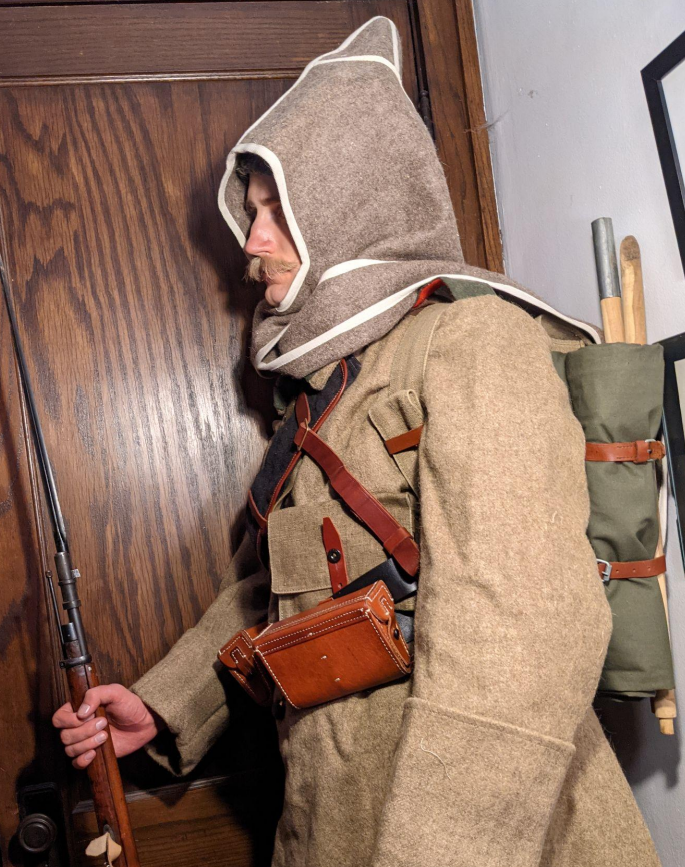
Summer 1915
HEADWEAR:
-Obr.1913 pea-green wool furazhka with green subdued visor
-Obr.1910 genuine karakul papakha
-Wartime-ersatz production artificial-fleece papakha
-Obr.1881 Bashlyk wool hood
BASE UNIFORM :
-Obr. 1911/1912 Gimnastyorka in wool. Brass eagle buttons now supplanted with horn buttons. 174-stamped shoulderboards now reversed to pea-green side.
TROUSERS:
-Obr.1907 Green-Black wool
-Obr.1913 Pea-green Wool
-Obr.1914 Cotton twill
GREATCOAT:
-Obr.1909/Obr.1911 Shinel. Both red insignia or subdued insignia allowed. Collar tabs no longer mandatory. Chest buttons can be either left on or off (in case of Obr.1911 in which they were merely decorative)
FOOTWEAR:
-Obr. 1908 Sapogi/Jackboots (All seasons)
-Felt valenki of varying heights and colors allowed (Winter wear only)
FIELD GEAR:
-Single or double Obr. 1909 leather ammunition pouches
-Obr.1900 leather/oilcloth or Obr.1915 canvas ersatz bandoleer
-Obr.1910 canvas ranyets pack (worn on back guards-style), Obr.1914 “Mobilization Meshok”, or Obr.1869 Turkestan-style cloth meshok
-Obr.1893 or Obr. 1915 Ersatz Reserve ammunition pouch
-Obr.1907 Brass eagle buckle and belt
-Obr. 1889/97 round mess pot in aluminum or copper, or Obr.1909 “kidney” copper messkit
-Obr.1884/1909 Aluminum canteen in wool cover with leather or cloth sling. Attachable underside 1909 underside cup encouraged but not mandatory
-Obr.1889 Linnemann-pattern entrenching tool in leather or canvas ersatz carrier
-“Red-Cross” model gauze gasmask or other improvised mask covering the nose and mouth
1916: Spring to September
HEADWEAR:
-Obr.1913 furazhka in wool, cotton twill, or plash material with green subdued cockade and visor
-“Moscow Committee” VZS gas mask consisting of separate gauze snout and goggles set
-Obr.1916 Zielinski gasmask with square filter allowed in small numbers
BASIC UNIFORM:
-Obr. 1911/1912 Gimnastyorka in wool, cotton twill, and plash material. Improvised chest pockets now allowed in small numbers. Wood, horn, bone, and metal dish buttons predominating. Shoulderboards now only pea-green subdued, with 174. stampings becoming less common as in early period of war.
-Obr. 1913/14 wool, cotton, and plash material trousers allowed.
GREATCOAT:
-Obr.1911 coat now predominating, with exclusively pea-green/shinel wool shoulderboards. Subdued collar tabs allowed but not mandatory. Shoulderboard and backbelt buttons subdued.
FOOTWEAR:
-Obr. 1908 Sapogi (All seasons)
-Canvas ersatz/Hot weather jackboot (Summer use)
FIELD GEAR:
-Doubled pair of Obr. 1915 canvas ersatz ammunition pouches
-Obr.1915 canvas ersatz bandoleer
-Obr.1915 single-prong simplified roller buckle belt
-Obr.1869 Turkestan-style cloth meshok
-Obr. 1889/97 round mess pot in aluminum or copper, or Obr.1909 “kidney” copper messkit
-Obr.1884/1909 Aluminum or glass canteen in cloth ersatz or wool cover.
-Obr.1889 Linnemann-pattern entrenching tool in leather or canvas ersatz carrier
Winter 1916-17 to Spring 1918
HEADWEAR:
-Obr.1913 furazhka in wool, cotton twill, or plash material with green subdued cockade and visor.
-Obr.1915 Adrian Helmet with “Moutard” painted Romanov badge. Helmet shell can be either matching Moutard or left in French horizon-blue.
-Ersatz wartime artificial fur papakha
-Obr.1916 Zielinski gasmask with both square and oval filters predominating.
-“Moscow Committee” VZS gasmasks and GAU Chemical Committee beak masks allowed also.
BASIC UNIFORM AND WINTER COATS:
-Obr. 1911/1912 Gimnastyorka in wool, cotton twill, and plash material. Improvised chest pockets now allowed for all ranks. Wood, horn, bone, and metal dish buttons predominating.
-Obr.1916 simplified tunic with irregular chest pockets and cuff shape.
-Shoulderboards now only pea-green subdued, with 174. stampings now decidedly in the minority.
-Obr. 1913/14 wool, cotton, and plash material trousers allowed.
-Obr. 1916 Padded jacket and pants set; also known as the “Telogreika”. Jacket can be with tie closures or button front. Either worn under the greatcoat or as a standalone fatigue uniform (more research on these needed).
-Obr. 1911 Greatcoat. Subdued buttons and insignia.
FOOTWEAR:
-Obr.1916 Ankle boots with cotton twill/wool knit puttees
-Obr. 1908 Sapogi -Knee-height Valenki (Christmas Battles took place in recorded temperatures of -40° ! )
FIELD GEAR:
-Single or double Obr. 1915 canvas ersatz ammunition pouches
-Obr.1915 canvas ersatz bandoleer
-Obr.1915 single-prong simplified roller buckle belt
-Obr.1869 Turkestan-style cloth meshok
-Obr. 1889/97 round mess pot in aluminum or copper, or Obr.1909 “kidney” copper messkit
-Obr.1884/1909 Aluminum or glass canteen in cloth ersatz or wool cover.
-Obr.1889 Linnemann-pattern entrenching tool in leather or canvas ersatz carrier
Istochnik WWI Film
Impression Photos


